The Enhanced Phase-Forming Capacity of (1–x)Mg0.95Co0.05TiO3-xCa0.6La0.8/3TiO3 Dielectric Ceramics Modified Using Multiple Sintering Aids
Abstract
1. Introduction
- The sol–gel process.
- Reductions in the particle size of the starting materials.
- Liquid-phase sintering by adding glass or other low-melting-point materials.
2. Experimental Procedure
3. Results and Discussion
4. Conclusions
Author Contributions
Funding
Data Availability Statement
Conflicts of Interest
References
- Freitas, A.E.; Manhabosco, T.M. Dielectric performance and physical characterization of (Mg0.6Zn0.4)0.95Ni0.05TiO3 ceramics with ATiO3 (A = Ca, Sr) additions for microwave applications. Materials 2020, 13, 386. [Google Scholar] [CrossRef]
- Aljaafari, A.; Sedky, A. Influence of Fine Crystal Percentage on the Electrical Properties of ZnO Ceramic-Based Varistors. Crystals 2020, 10, 681. [Google Scholar] [CrossRef]
- Yu, H.; Luo, T.; He, L.; Liu, J. Effect of ZnO on Mg2TiO4–MgTiO3–CaTiO3 microwave dielectric ceramics prepared by reaction sintering route. J. Adv. Appl. Ceram. 2019, 118, 98–105. [Google Scholar] [CrossRef]
- Zhai, S.; Liu, P.; Fu, Z. Microwave dielectric properties of low-fired [Mg0.98(Li0.5Bi0.5)0.02]2SiO4–Ca0.8Sm0.4/3TiO3 composite ceramics. J. Mater. Sci. Mater. Electron 2018, 29, 1298–1303. [Google Scholar] [CrossRef]
- Palmero, P. Structural ceramic nanocomposites: A review of properties and powders’ synthesis methods. Nanomaterials 2015, 5, 656–696. [Google Scholar] [CrossRef]
- Tang, B.; Xiang, Q.; Fang, Z.; Zhang, X.; Xiong, Z.; Li, H.; Yuan, C.; Zhang, S. Influence of Cr3+ substitution for Mg2+ on the crystal structure and microwave dielectric properties of CaMg1-xCr2x/3Si2O6 ceramics. Ceram. Int. 2019, 45, 11484–11490. [Google Scholar] [CrossRef]
- Yuan, S.; Gan, L.; Ning, F.; An, S. High-Q×f 0.95MgTiO3–0.05CaTiO3 microwave dielectric ceramics with the addition of LiF sintered at medium temperatures. Ceram. Int. 2018, 44, 20566–20569. [Google Scholar] [CrossRef]
- Chen, Y.C.; Su, C.F.; Weng, M.Z.; You, H.M. Improvement microwave dielectric properties of Zn2SnO4 ceramics by substituting Sn4+ with Si4+. J. Mater. Sci. Mater. Electron. 2014, 25, 2120–2125. [Google Scholar] [CrossRef]
- Shen, C.H.; Pan, C.L. Structure, dielectric properties, and applications of (Na0.5Sm0.5)TiO3-modified (Mg0.95Ni0.05)TiO3 ceramics at microwave frequency. Mater. Res. Bull. 2015, 65, 169–174. [Google Scholar] [CrossRef]
- Wang, H.P.; Yang, Q.; Li, D.; Huang, L. Sintering Behavior and Microwave Dielectric Properties of MgTiO3 Ceramics Doped with B2O3 by Sol-Gel Method. J. Mater. Sci. Technol. 2012, 28, 751–755. [Google Scholar] [CrossRef]
- Wang, H.P.; Xu, S.Q.; Zhai, S.Y.; Deng, D.G. Effect of B2O3 Additives on the Sintering and Dielectric Behaviors of CaMgSi2O6 Ceramics. J. Mater. Sci. Technol. 2010, 26, 351–354. [Google Scholar] [CrossRef]
- Gogoi, P.; Singh, L.R.; Pamu, D. Characterization of Zn doped MgTiO3 ceramics: An approach for RF capacitor applications. J. Mater. Sci. Mater. Electron. 2017, 28, 11712–11721. [Google Scholar] [CrossRef]
- Ullah, A.; Iqbal, Y.; Mahmood, T.; Mahmood, A.; Naeem, A.; Humayun, M. Kinetic analysis on the synthesis of Mg0.95Zn0.05TiO3 microwave dielectric ceramic by polymeric precursor method. Ceram. Int. 2015, 41, 15089–15096. [Google Scholar] [CrossRef]
- Huang, C.L.; Pan, C.L. Dielectric properties of (1−x)(Mg0.95Co0.05)TiO3–xCaTiO3 ceramic system at microwave frequency. Mater. Res. Bull. 2002, 37, 2483–2490. [Google Scholar] [CrossRef]
- Sohn, J.H.; Inaguma, Y.; Yoon, S.O. Microwave Dielectric Characteristics of Ilmenite-Type Titanates with High Q Values. Jpn. J. Appl. Phys. 1994, 33, 5466. [Google Scholar] [CrossRef]
- Wakino, K. Recent development of dielectric resonator materials and filters in Japan. Ferroelectrics 1989, 91, 69–86. [Google Scholar] [CrossRef]
- Huang, C.L.; Shen, C.H. Dielectric properties and applications of low loss (1 − x)(Mg0.95Co0.05)TiO3–xCa0.8Sm0.4/3TiO3 ceramic system at microwave frequency. J. Alloys Compd. 2009, 468, 516–521. [Google Scholar] [CrossRef]
- Kakada, T.; Wang, S.F.; Yoshikawa, S.; Jang, S.T.; Newnham, R.E. Effect of Glass Additions on BaO–TiO2–WO3 Microwave Ceramics. J. Am. Ceram. Soc. 1994, 77, 1909. [Google Scholar]
- Kakada, T.; Wang, S.F.; Yoshikawa, S.; Jang, S.T.; Newnham, R.E. Effects of Glass Additions on (Zr, Sn)TiO4 for Microwave Applications. J. Am. Ceram. Soc. 1994, 77, 2485. [Google Scholar]
- Hirnom, S.I.; Hayashi, T.; Hattori, A. Chemical Processing and Microwave Characteristics of (Zr, Sn)TiO4 Microwave Dielectrics. J. Am. Ceram. Soc. 1991, 74, 1320. [Google Scholar]
- Tolmer, V.; Desgardin, G. Low-Temperature Sintering and Influence of the Process on the Dielectric Properties of Ba(Zn1/3Ta2/3)O3. J. Am. Ceram. Soc. 1997, 80, 1981. [Google Scholar] [CrossRef]
- Shen, C.H.; Huang, C.L. Characterization and dielectric behavior of V2O5-doped 0.9Mg0.95Co0.05TiO3–0.1Ca0.6La0.8/3TiO3 ceramic system at microwave frequency. J. Alloys Compd. 2010, 489, 170–174. [Google Scholar] [CrossRef]
- Shen, C.H.; Huang, C.L. Characterization and dielectric behavior of B2O3-doped 0.9Mg0.95Co0.05TiO3–0.1Ca0.6La0.8/3TiO3 ceramic system at microwave frequency. J. Alloys Compd. 2010, 504, 228–232. [Google Scholar] [CrossRef]
- Hakki, B.W.; Coleman, P.D. A dielectric resonator method of measuring inductive capacities in the millimeter range. IRE Trans. Microw. Theory Tech. 1960, 8, 402–410. [Google Scholar] [CrossRef]
- Courtney, W.E. Analysis and evaluation of a method of measuring complex permittivity and permeability of microwave materials. IEEE Trans. Microw. Theory Tech. 1970, 18, 476–485. [Google Scholar] [CrossRef]
- Huang, C.L.; Pan, C.L. Low-temperature sintering and microwave dielectric properties of (1−x)MgTiO3–xCaTiO3 ceramics using bismuth addition. Japan. J. Appl. Phys. 2002, 41, 707. [Google Scholar] [CrossRef]
- Liao, J.; Senna, M. Crystallization of titania and magnesium titanate from mechanically activated Mg(OH)2 and TiO2 gel mixture. Mater. Res. Bull. 1995, 30, 385. [Google Scholar] [CrossRef]
- Huang, C.L.; Shen, C.H. Phase Evolution and Dielectric Properties of (Mg0.95M0.052+)Ti2O5 (M2+=Co, Ni, and Zn) Ceramics at Microwave Frequencies. J. Am. Ceram. Soc. 2009, 92, 384. [Google Scholar] [CrossRef]
- Silverman, B.D. Microwave absorption in cubic strontium titanate. Phys. Rev. 1962, 125, 1921. [Google Scholar] [CrossRef]
- Gurevich, G.L.; Tagantsev, A.K. Intrinsic dielectric loss in crystals: Low temperature. Sov. Phys. JETP 1986, 64, 142–151. [Google Scholar]
- Gurevich, G.L.; Tagantsev, A.K. Intrinsic dielectric loss in crystals. Adv. Phys. 1991, 40, 719–767. [Google Scholar] [CrossRef]
- Kajfezz, D.; Guillon, P. Dielectric Resonators; Noble Publishing Corporation: Tucker, GA, USA, 1998; pp. 10–62. [Google Scholar]
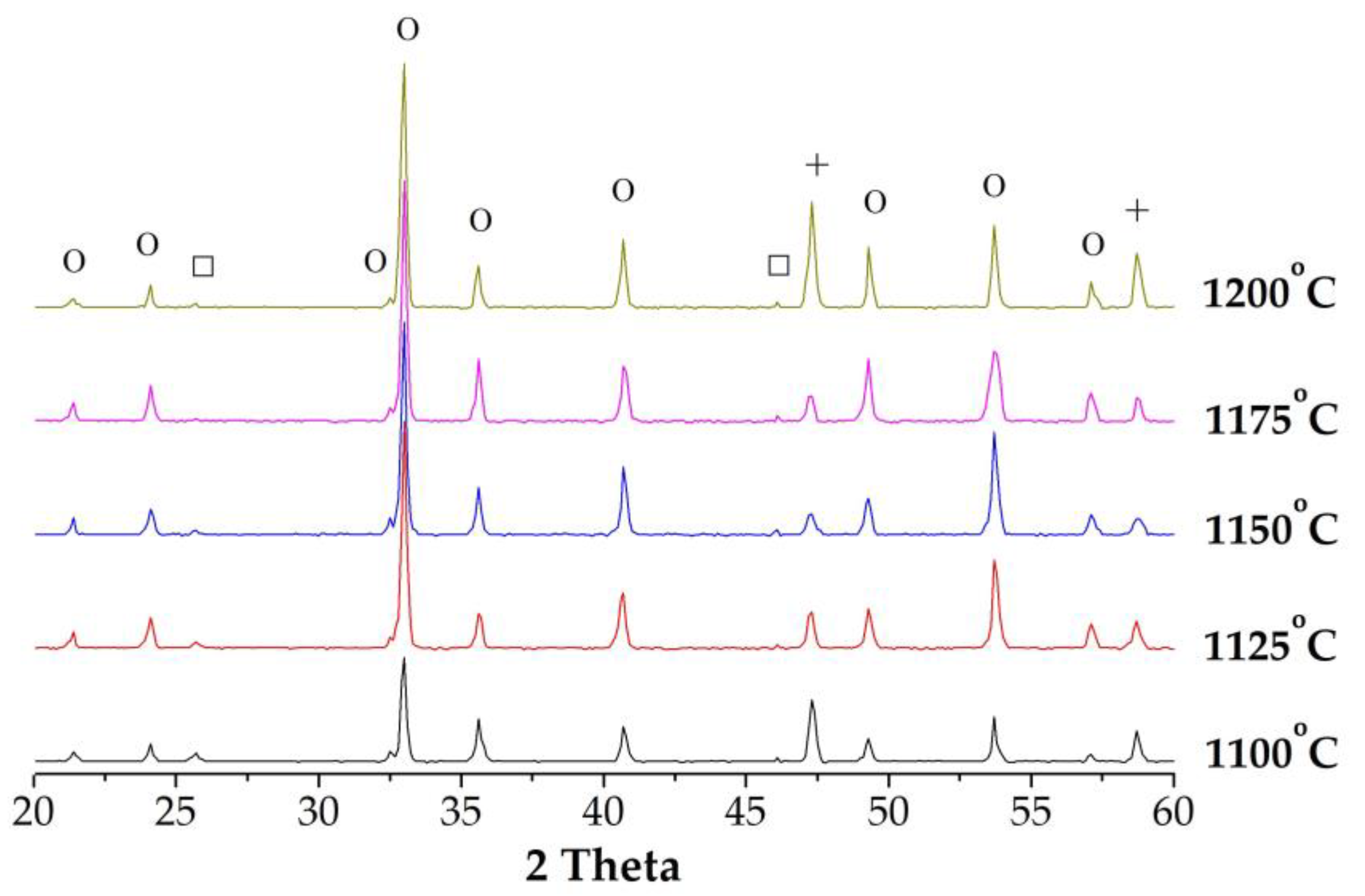
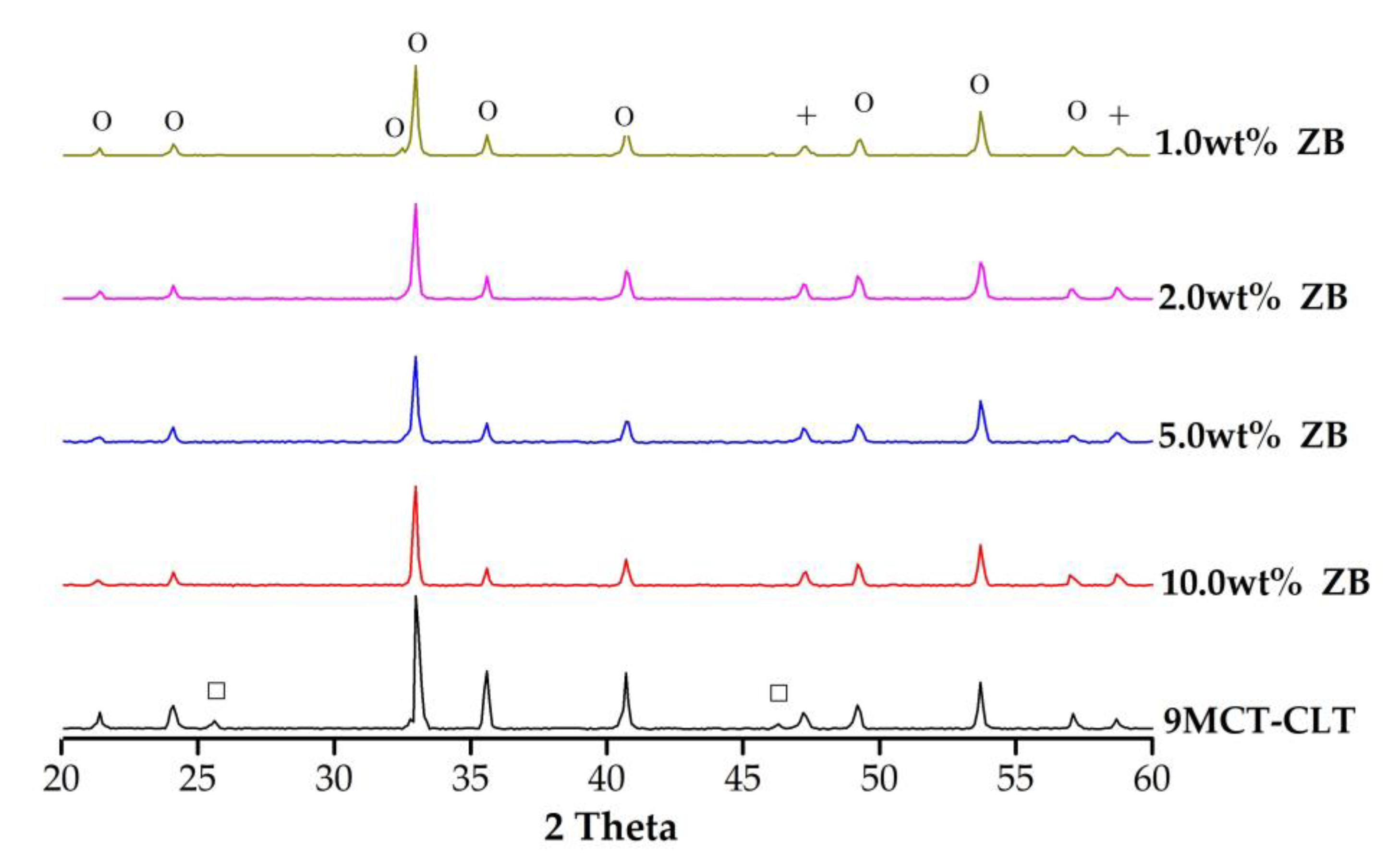
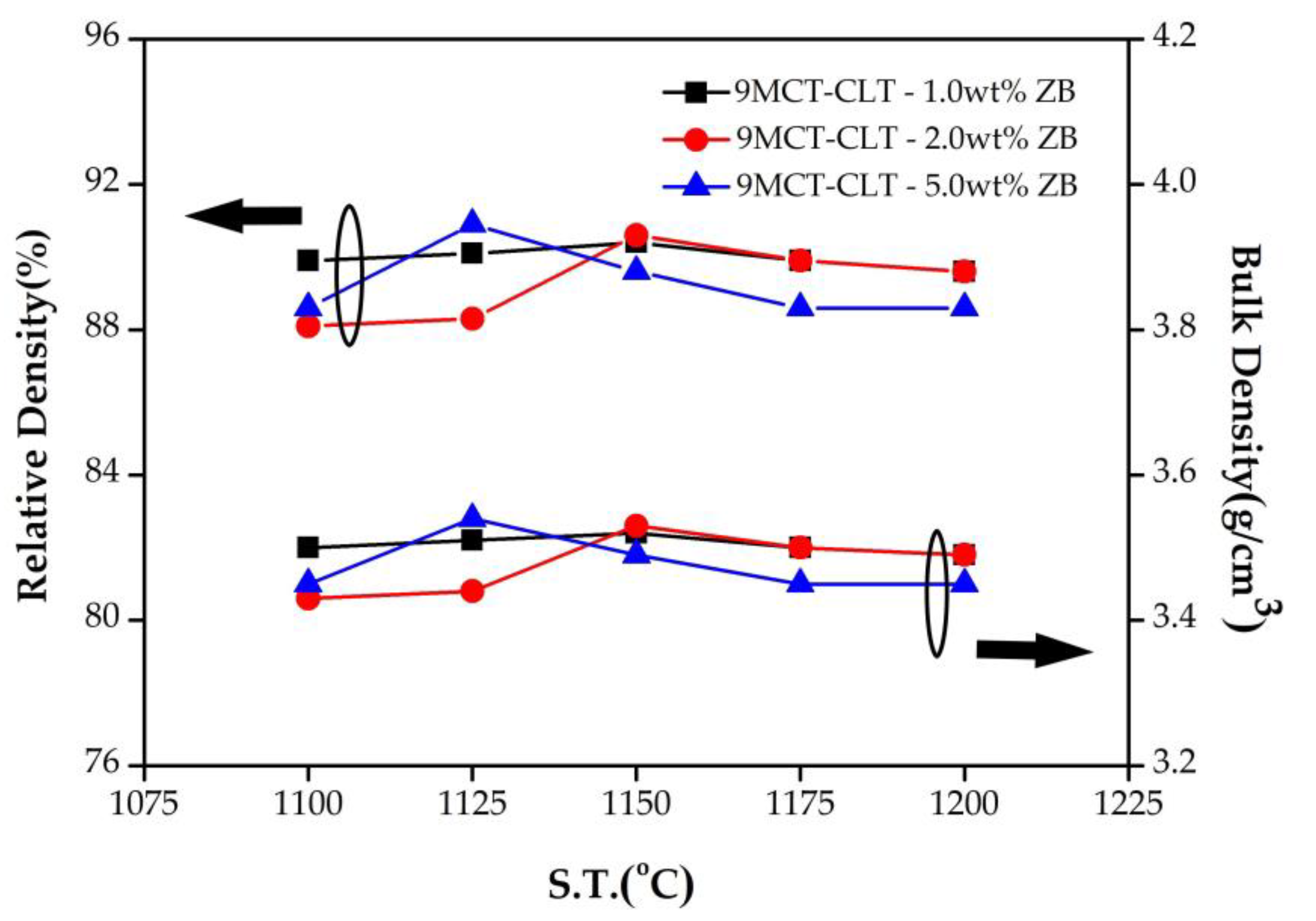
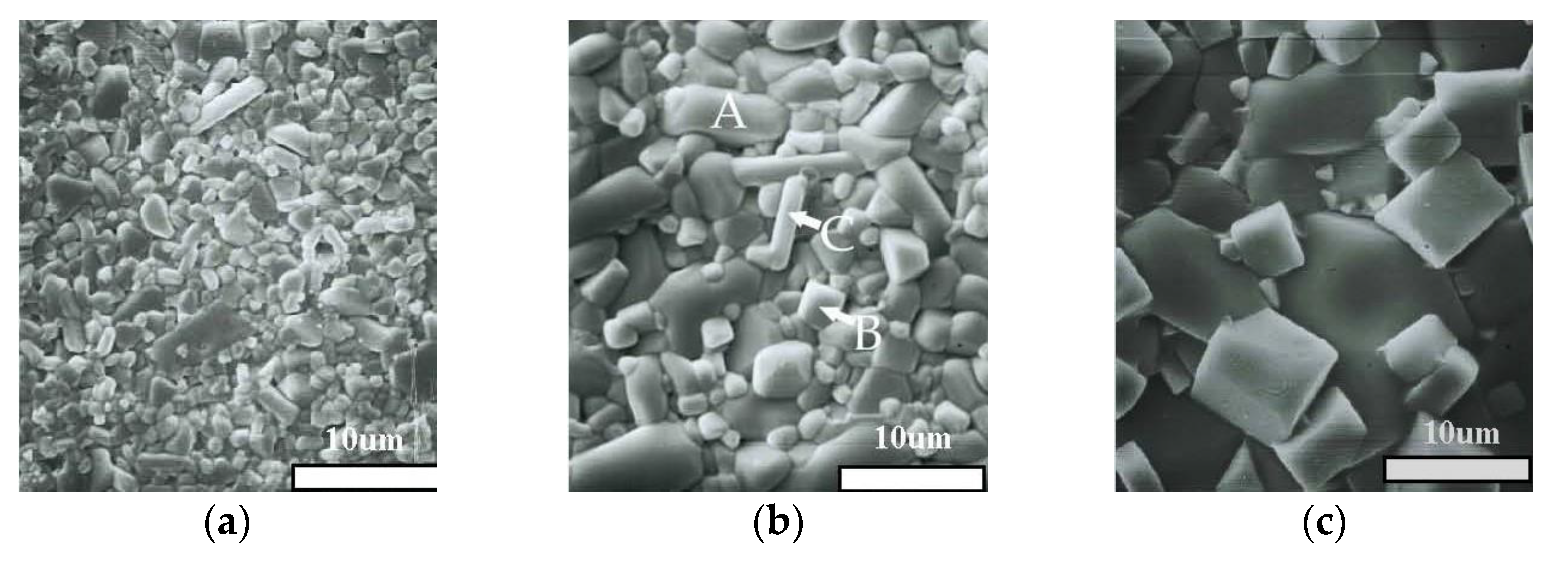

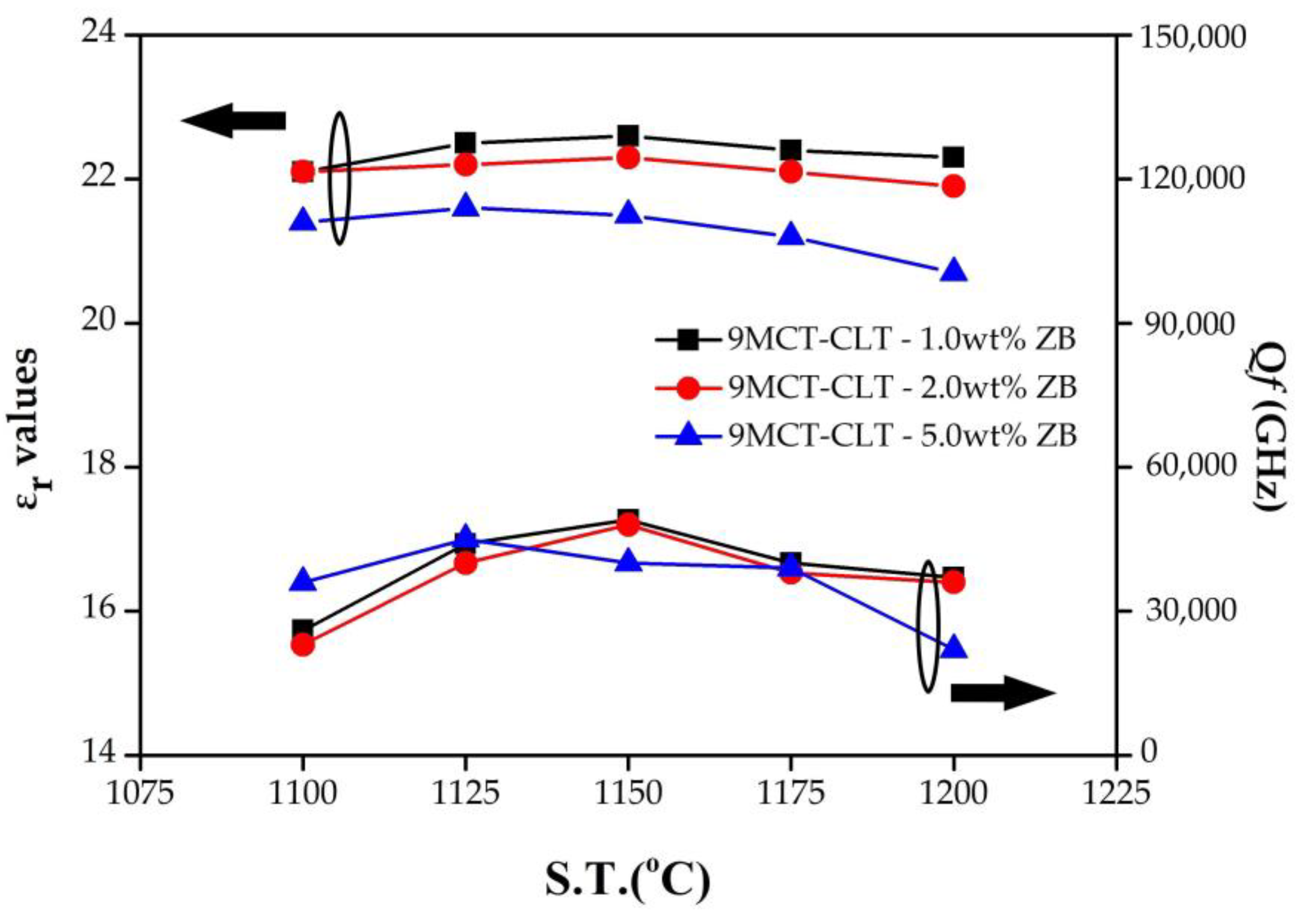

| Temperatures | a (Å) | c (Å) | MCT Ratio (%) | CLT Ratio (%) | MgTi2O5 Ratio (%) |
|---|---|---|---|---|---|
| 1100 | 5.0509 ± 0.0136 | 13.9048 ± 0.0276 | 70.3 | 21.9 | 7.8 |
| 1125 | 5.0515 ± 0.0128 | 13.9212 ± 0.0260 | 80.7 | 16.6 | 2.7 |
| 1150 | 5.0509 ± 0.0136 | 13.9048 ± 0.0276 | 91.7 | 6.5 | 1.8 |
| 1175 | 5.0509 ± 0.0136 | 13.9048 ± 0.0276 | 90.5 | 7.9 | 1.6 |
| 1200 | 5.0470 ± 0.0117 | 13.9006 ± 0.0237 | 88.1 | 10.3 | 1.6 |
| Additives | Content (wt%) | a (Å) | c (Å) |
|---|---|---|---|
| ZnO-B2O3 | 1.0 wt% | 5.0509 ± 0.0136 | 13.9048 ± 0.0276 |
| 2.0 wt% | 5.0438 ± 0.0212 | 13.8768 ± 0.0427 | |
| 5.0 wt% | 5.0509 ± 0.0136 | 13.9048 ± 0.0276 | |
| 10 wt% | 5.0682 ± 0.0070 | 13.9149 ± 0.0141 |
| Atom (%) | ||||||
|---|---|---|---|---|---|---|
| Spot | Mg | Co | Ca | La | Ti | O |
| A | 20.69 | 1.58 | 0 | 0 | 19.39 | 58.34 |
| B | 0 | 0 | 24.38 | 13.16 | 39.65 | 22.80 |
| C | 19.45 | 2.12 | 0 | 0 | 41.68 | 36.75 |
| Compositions | S.T. (°C) | εr | Qf (GHz) | τf (ppm/°C) |
|---|---|---|---|---|
| MgTiO3 | 1450 | 17 | 160,000 | −51 |
| Mg0.95Co0.05TiO3 | 1450 | 16.8 | 230,000 | −54 |
| Ca0.6La0.8/3TiO3 | 1400 | 109 | 17,600 | 213 |
| Additives | Content (wt%) | S.T. (°C) | D (g/cm3) | εr | Qf (GHz) | τf (ppm/°C) | Ref. |
|---|---|---|---|---|---|---|---|
| undoped | 0 | 1350 | 3.93 | 21.8 | 131,000 | −15.5 | |
| V2O5 | 0.25 | 1250 | 3.54 | 21.7 | 58,000 | −10 | [22] |
| B2O3 | 0.50 | 1225 | 3.55 | 22.67 | 76,000 | −12 | [23] |
| ZB | 0.50 | 1175 | 3.80 | 22.5 | 57,000 | −13.6 | |
| 1.00 | 1150 | 3.52 | 22.6 | 49,000 | −12.8 | ||
| 2.00 | 1150 | 3.53 | 22.3 | 48,000 | −13.0 | This work | |
| 5.00 | 1125 | 3.54 | 21.6 | 45,000 | −14 | ||
| 10.0 | 1100 | 3.56 | 20.3 | 39,000 | −14.2 |
Disclaimer/Publisher’s Note: The statements, opinions and data contained in all publications are solely those of the individual author(s) and contributor(s) and not of MDPI and/or the editor(s). MDPI and/or the editor(s) disclaim responsibility for any injury to people or property resulting from any ideas, methods, instructions or products referred to in the content. |
© 2023 by the authors. Licensee MDPI, Basel, Switzerland. This article is an open access article distributed under the terms and conditions of the Creative Commons Attribution (CC BY) license (https://creativecommons.org/licenses/by/4.0/).
Share and Cite
Pan, C.-L.; Shen, C.-H.; Lin, K.-C. The Enhanced Phase-Forming Capacity of (1–x)Mg0.95Co0.05TiO3-xCa0.6La0.8/3TiO3 Dielectric Ceramics Modified Using Multiple Sintering Aids. Crystals 2023, 13, 927. https://doi.org/10.3390/cryst13060927
Pan C-L, Shen C-H, Lin K-C. The Enhanced Phase-Forming Capacity of (1–x)Mg0.95Co0.05TiO3-xCa0.6La0.8/3TiO3 Dielectric Ceramics Modified Using Multiple Sintering Aids. Crystals. 2023; 13(6):927. https://doi.org/10.3390/cryst13060927
Chicago/Turabian StylePan, Chung-Long, Chun-Hsu Shen, and Kuei-Chih Lin. 2023. "The Enhanced Phase-Forming Capacity of (1–x)Mg0.95Co0.05TiO3-xCa0.6La0.8/3TiO3 Dielectric Ceramics Modified Using Multiple Sintering Aids" Crystals 13, no. 6: 927. https://doi.org/10.3390/cryst13060927
APA StylePan, C.-L., Shen, C.-H., & Lin, K.-C. (2023). The Enhanced Phase-Forming Capacity of (1–x)Mg0.95Co0.05TiO3-xCa0.6La0.8/3TiO3 Dielectric Ceramics Modified Using Multiple Sintering Aids. Crystals, 13(6), 927. https://doi.org/10.3390/cryst13060927






